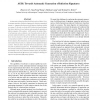58 search results - page 4 / 12 » Detection of New Malicious Code Using N-grams Signatures |
ICSM
2009
IEEE
15 years 5 months ago
2009
IEEE
To defeat current commercial antivirus software, the virus developers are employing obfuscation techniques to create mutating viruses. The current antivirus software cannot handle...
119
click to vote
EUROCRYPT
2003
Springer
15 years 4 months ago
2003
Springer
Abstract. Digital Signatures emerge naturally from Public-Key Encryption based on trapdoor permutations, and the “duality” of the two primitives was noted as early as Diffie-He...
DSN
2008
IEEE
15 years 5 months ago
2008
IEEE
An important yet largely uncharted problem in malware defense is how to automate generation of infection signatures for detecting compromised systems, i.e., signatures that charac...
113
click to vote
TACAS
2012
Springer
13 years 6 months ago
2012
Springer
The number of malware is growing extraordinarily fast. Therefore, it is important to have efficient malware detectors. Malware writers try to obfuscate their code by different tec...
DIMVA
2006
15 years 10 days ago
2006
Next generation malware will by be characterized by the intense use of polymorphic and metamorphic techniques aimed at circumventing the current malware detectors, based on pattern...


